These dark sky parks give you a glimpse into a galaxy far, far away
Ready to teach your kids about their place in the universe? Start by looking at the stars! From Arches National Park in Utah to Acadia Park in Maine, we’ve compiled a list of the best “Dark Sky Parks” where you and your little astronomers can go to gaze up at the heavens. So grab your binoculars, get to know your constellations, and get ready to feel the vastness of it all.
Stargazing in Death Valley National Park | California
If your kids can get past the ominous name of this gorgeous expanse of Mohave Desert, they'll be ready to gaze upon one of the darkest skies in the country. Spanning 3.4 million acres of California near the Nevada border, this park is the largest national park outside Alaska. It is also known to be the hottest, driest, and lowest point in North America—but don't let that stop you from visiting; with its glittering sand dunes, otherworldly salt flat floors, and golden peaks everywhere you turn, it's a gorgeous park to visit, even with littles in tow.
Fun fact: Death Valley was given its name by a group of pioneers lost here in the winter of 1849-1850.
By Day: From sand-surfing the dunes to watching saltwater fish popping in and out of the valley's creek, Death Valley has more life to it than its name would suggest. Don't miss Artist’s Drive, a nine-mile, one-way road where the wide expanse of sedimentary and volcanic rocks look like they've been spray-painted with unexpected hues of yellows, pinks, and greens (Psst: It's all natural!). You'll also want to take the hike to Badwater Basin, the lowest point in North America, where the salt flats stretch out like hard snow floors. And, kids will love trotting down the boardwalk at the Salt Creek Interpretive Trail, where they can see the native pupfish plopping in and out of the water.
By Night: Pull off the empty roads and find a spot to look up. With its remote location and lack of many nearby cities, Death Valley's skies are famous for its glittering sea of stars. In fact, The International Dark Sky Association has said that stargazing here offers “views close to what could have been seen before the rise of cities." Even at the nearby Stovepipe Wells Hotel, one of the most renowned lodges in the area, nighttime lighting is "sky friendly" (it uses red, rather than white, light) to preserve the sky's starscape for viewing.
Best Time of Year to Go: September through March (Don't go in the summer, when it can get up to 130 degrees on a hot day!)
More Information: Nps.gov/deva
Stargazing at Arches National Park | Utah
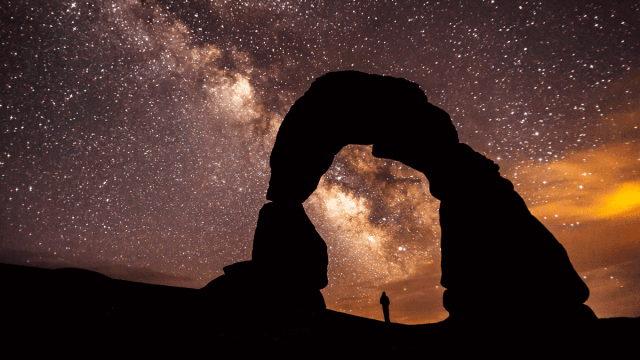
Known for its more than 2,000 delicate sandstone arches that tower toward the sky like magical red rock doorways, this park offers a plethora of easy to moderate hikes that visitors can explore by day—and a glorious sea of stars to gaze upon by night.
By Day: Kids will love scrambling across the rocky and sandy terrain, so make sure they've got sturdy sneakers or hiking boots. Many of the best hikes are relatively easy, according to this travel blogger (who hiked the park with three kids under three!), and the best trails for little hikers include the Balanced Rock Hike (.3 miles round trip), Sand Dune Arch Hike (.3 miles round trip), and the Double Arch Hike (1.2 miles round trip).
Insider Tip: Be sure to pick up a Junior Ranger Program from the park's Visitor Center (or download it here), which gives kids fun activities to complete for the chance to win a ranger's badge. The visitor center also sells "Explorer Packs" that contain binoculars, a hand lens, a naturalist guide, a notebook, and activities to inspire exploration.
By Night: Since it has minimal artificial lighting (there's light at one administrative area by the highway and "sky-friendly lighting" for safety at a few spots around the park), Arches offers some of the darkest skies in the contiguous 48 United States. According to the NPS, a pair of simple binoculars on a moonless night here may be enough to see even the rings around Saturn! Arches occasionally offers ranger-led stargazing events, so keep an eye on the website to find out when one might be planned. Otherwise, the best spots to see the stars include*:
*All of these spots offer parking areas, so you don't have to be camping to enjoy the views. Just pull up, turn off your lights, and look up. (You can stay by your car or walk a short distance into the park to get a more isolated view.)
Best Time of Year to Go: Spring or fall. Note: You'll see the most stars during the new moon or when the moon is below the horizon, so plan your visit accordingly. Check sunrise and sunset times and moon phases at discovermoab.com.
More Information: Nps.gov/arch
Related: Your Guide to Mastering Astronomy with Kids
Stargazing in Bryce Canyon National Park | Utah
Famous for its thousands of pointed spires called “hoodoos,” Bryce Canyon is part of a geologic spectacle known as the Grand Staircase, layered over millions of years. While it is known as a hiking mecca by day, it's also firmly dedicated to its night skies, with what the NPS calls a "special force of park rangers and volunteer astronomers" keeping its skies dark. On a good night, you can see the Milky Way extending from horizon to horizon, with a sea of stars and planets glowing all around.
By Day: Don't miss the most iconic section of the park, the Bryce Amphitheater, which is home to the greatest concentration of hoodoos on the planet! This otherworldly vista is viewable from the main road from various overlooks where you can get out of your car and take it all in. Of course, the best way to see the park—if you're up for it—is by hike, and there are plenty of day hikes that promise amazing views— from the Rim Trail, an easy walk along the edge of Bryce Amphitheater; to the Queen's Garden Trail, which leads hikers on a moderately-easy hike through rock arches and inclines to a sweeping view of the hoodoos (this article on Traveling Dad has a great description of this hike).
By Night: Bryce Canyon’s astronomy program is considered the longest active astronomy program in the National Park Service, with dark night tours and telescope viewings offered on weekends in the summer. On a clear night, spectators can see between 7,500-10,000 stars, including a jaw-dropping view of the Milky Way. Check out the park's Astronomy Programs page to find out more.
Best Time of Year to Go: May through September.
More Information: Nps.gov/brca
Stargazing in Acadia National Park | Maine
The only official National Park in the Northeast, Acadia includes more than 45,000 acres of coastal land near Bar Harbor, Maine, as well as 20 different islands off the coast. It is best known for its breathtaking ocean vistas, sandy beaches, and pristine network of coastal trails—many of which are easy treks for little hikers.
By Day: Hike one of the 125 miles of coastal trails (here's a great guide to the best kid-friendly hikes in Acadia), or—if you'd rather see the views by car—take a drive down Park Loop Road, a twisty 27-mile drive located on the eastern half of Mount Desert Island. (Note: This road is closed from December through April.) In the summer, Sand Beach is a perfect spot for littles to splash around in the water—there are also kayaks and boats available to rent if you want the chance to spot the area's aquatic residents, including harbor porpoises, seals, and humpback whales. Horse and carriage rides are also offered in the warmer months.
By Night: With one of the best stretches of dark skies east of the Mississippi, aspiring astronomers can gather on Sand Beach for regular ranger programs to learn about the local visible constellations (this is generally offered in warmer months, but check the park calendar for more details). Other great spots to see the vastness of space include the west side of Mount Desert Island (known as Seawall) as well as the shores of Jordan Pond, Acadia's clearest lake.
Best Time Of Year to Go: Summer or early fall
More Information: Nps.gov/acadia
Related: New England’s Most Scenic National Parks (& Amazing Nearby Cabins)
Stargazing in Joshua Tree | California
https://www.instagram.com/p/CZkeg_IPAGG/?hidecaption=true
Located a short afternoon's drive from Los Angeles, this urbanite's escape offers hikers a vast array of rocks to scramble across as well as desert trails that go on for miles. By night, it has some of the darkest skies in Southern California, which is why Angelinos have long used it as a place to look to the stars.
By Day: Tiny rock climbers will love climbing the boulders as they traverse the trails throughout the park. We recommend the Hidden Valley Trail, a one-mile hike that takes you past many a Joshua tree and through a massive rock valley, where kids can climb and run while they keep a lookout for chipmunks, lizards, and cacti.
By Night: If you visit April through October, you'll be able to see the Milky Way twinkling across the sky. The park offers regular ranger-led star programs; check the calendar to find more.
And while you don't need to spend the night at the park to enjoy the night skies (there are many pullouts accessible by car from the road), those who want to camp can choose from nine campgrounds (according to the NPS website, Cottonwood Campground has the darkest skies). If you're just doing a drive-in, NPS recommends parking at any of the roadside pullouts and setting up chairs within 20 feet of your vehicle. We recommend heading to Skull Rock, an imposing rock formation right near the road that's a great spot for stargazing.
Pssst: Want to stargaze in style? We love this "Bubble Hotel" which allows you to lay in luxury and gaze at the stars from the comfort of a queen bed inside a climate-controlled "bubble."
Best Time of Year to Go: Fall to Spring. Note: Stargazing is great year-round here, but if you also want to spend your days on the trails, the summers are too hot to enjoy the park safely.
More Information: Nps.gov/jotr
Related: Luxury Camping & Joshua Tree National Park All in One (Glorious) Place
Stargazing in Great Basin National Park | Nevada
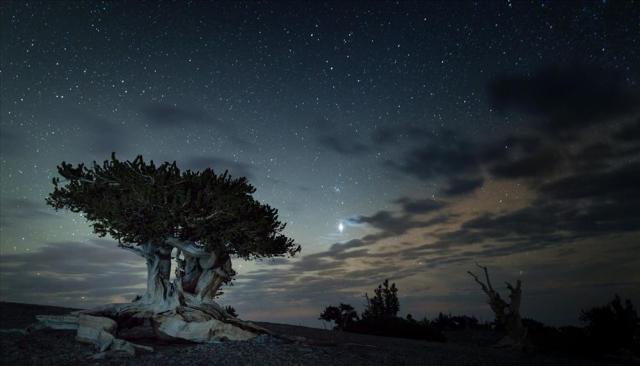
With its low humidity, high elevation, and 77,000 acres of untouched wilderness, this stretch of land offers stunningly dark skies and some unique ways to view them.
By Day: Take a drive on the aptly-named "Scenic Drive," a 12-mile road that ascends 4,000 feet that passes through so many specific ecosystems that the NPS calls it the ecological equivalent of driving from Baker, Nevada, to the frozen Yukon, thousands of miles to the north. Once you're at the top, take a hike on the easy, quarter-mile Island Forest Trail, which weaves around creeks and meadows through the alpine forest.
Want to go deeper? Book a ranger-led tour of the Lehman caves, an underground wonderland that was formed millions of years ago. (You can take a virtual tour here to get a taste of what to expect). Families with small children or kids who are afraid of the dark may want to think twice since the caves are only dimly lit (and visitors are advised not to touch the cave walls, which may be tough for tiny explorers). Tip: Families may want to opt for the 30-minute Gothic Palace Tour, which offers a look inside one of the larger "rooms" (stalactites and stalagmites galore!) without the longer time commitment.
By Night: Kids can peer through telescopes during weekly astronomy programs held by the park’s “dark rangers." These star programs are generally held May through September on Saturday nights, as well as Thursday nights between Memorial Day and Labor Day. There's also a Perseid meteor shower-watching party in mid-August, where you'll be able to see hundreds of shooting stars per hour!
Want something totally different? Take a ride on the "Star Train," one of the coolest stargazing opportunities we've seen yet. This popular train travels into the park from the nearby city of Ely with rangers on board to point out all the wonders of the night sky. Passengers also get to hop off the train and take a look through telescopes to get a closer view. All trains for 2023 are already sold out (!!), but keep an eye on the website in case there are any cancellations. You can also still get a ticket on the "Sunset, Stars and Champagne" train ride, which leaves at sunset and comes back late enough at night to give riders a starry night show.
Best Time of Year to Go: Summer
More Information: Nps.gov/grba
Stargazing in Badlands National Park | South Dakota

Known for its otherwordly mountains and canyons of layered rock—as well as the grassy prairies surrounding them—this 244,000-acre park is home to bison, bighorn sheep, prairie dogs, and black-footed ferrets. Located about an hour from Rapid City, it is also a rich fossil site, and littles will love seeing evidence of the park’s long-ago residents as they make their way on the trails.
By Day: Take a drive on Badlands Loop Road, which takes you past 15 scenic overlooks to see the park’s majestic views. As for hikes, we recommend the easy 0.25-mile Fossil Exhibit Trail, a lazy walk where kids can learn about the different fossils found in the area.
Pssst: Badlands has an “open hike” policy, which means hikers are allowed to go off the trail. For kids, this means rock scrambling is totally OK! (Just keep an eye that nobody is getting near any steep drop-offs.)
By Night: The park offers special Night Sky Viewings every night in August and September. At these viewings, park rangers and volunteers use laser pointers to show and describe different constellations, planets, and other objects in the night sky. Spectators are also welcome to use the park’s 11-inch Celestron telescopes to get an even better look at the night sky.
Pssst: Be sure kids pick up a Night Explorer Junior Ranger Booklet from the Ben Reifel Visitor Center so they can complete it and earn a Junior Ranger Badge!
Best Time to Go: Late spring and early fall (summers can get hot and crowded)
More Information: Nps.gov/badl
Stargazing Chaco Culture National Historical Park | New Mexico
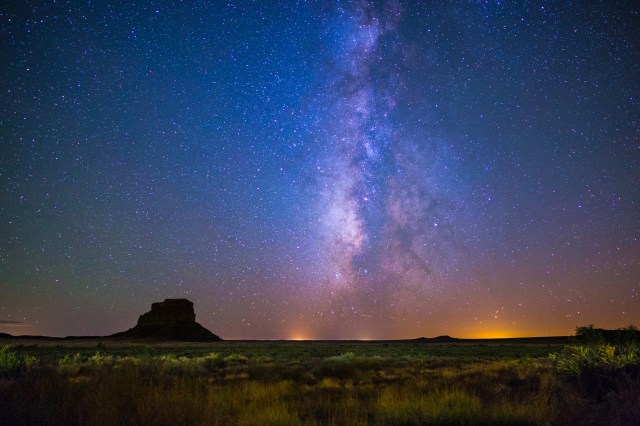
Located in an isolated desert canyon about three hours from Albuquerque, this UNESCO World Heritage site was the hub for the Chacoan culture between 850 and 1150 AD. A testament to the ancestral Puebloan people's complex engineering abilities, many of the ancient stone houses, petroglyphs, and other structures still stand strong, and visitors can still meander through their ancient doorways and corridors.
By Day: Kids can play archeologist as they walk around the red stone walls and hallways that connected this ancient center. On the surrounding trails, which offer expansive views from higher mesas, keep an eye out for the area's natural inhabitants, including elk, deer, bobcats, rabbits, badgers, porcupines, bats, snakes, and lizards. Stop at the visitor center to pick up a junior ranger booklet so kids can earn a junior ranger badge by learning more about ancestral Pueblo life.
By Night: Chaco Canyon is one of only two national parks with its own observatory, offering views into deep space and a digital imaging system that gives visitors views of distant nebulas and galaxies (open weekends through the summer and on special occasions in the winter). Evening campfire talks and night sky programs are usually held April through October, and give visitors a chance to look through high-powered telescopes and learn about the stars' crucial role in Chacoan culture*. There are also full moon walks through the ruins as well as walks held on solstices and equinoxes.
Staying the night? There is no lodging within 60 miles of the park, so you'll have to drive an hour to get to a hotel, or stay at one of the park's campsites (worth doing, since this is one the darkest skies in the American Southwest!).
*As of this publication, the ranger-led night sky programs have been suspended until further notice.
Best Time of Year to Go: Spring or fall.
More Information: Nps.gov/chcu
Stargazing in Big Bend National Park | Texas
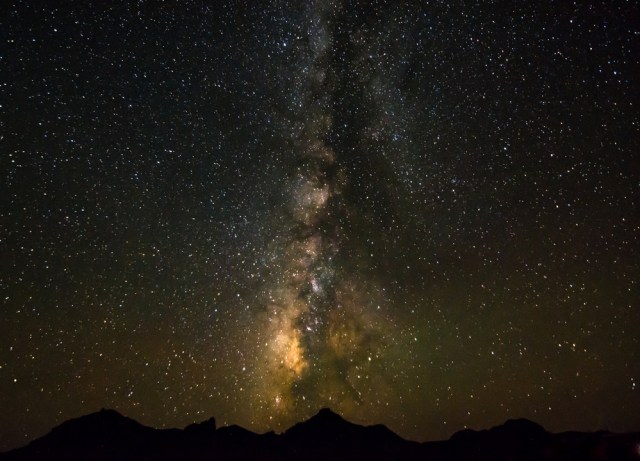
This expansive stretch of desert—the 12th largest national park in the country—is located on the southwestern border between Texas and Mexico. Despite the fact that it is the largest of North America’s four deserts, it is brimming with life due to being carved out by the "big bend" of the Rio Grande river that gives the park its name. The park's menagerie of animals includes more than 450 species of birds, 75 species of mammals, 56 species of reptiles, and 11 species of amphibians. But all that's nothing to the number of stars visible on a clear, moonless night.
By Day: Hikes around the nearby canyons and within the Chisos basin range from very easy to challenging (the park is known to have an active bear and mountain lion population, so parents are urged to use extra caution if hiking up into the mountains and foothills, where these animals tend to live). We recommend the 0.3-mile paved "Window View" trail around the Basin store, which is perfect for littles.
If you've got kids over 4, consider "floating" the Rio Grande by way of raft or canoe. Trips can be arranged by outside outfitters including Big Bend River Tours and Big Bend Boating and Hiking Company. If you're adventurous and everyone in your crew has a passport, take a five-minute row boat ride across the Rio Grande to the town of Boquillos Del Carmen, a quaint village that ParenthoodandPassports calls "the safe Mexico border town a boat ride away."
Note: Be sure to stop at the Panther Junction visitor center when you arrive at the park, where rangers can help you plan your day, tell you about any road closures, and give your kids Junior Ranger activity booklets.
By Night: This international dark-sky park has the least light pollution of any park in the lower 48 states. On a clear night, visitors can see the Andromeda Galaxy, two million light years away! Consequently, the park offers several types of night sky programs throughout the year, with dedicated "night sky rangers" there to teach visitors about all things far, far away.
To stay overnight in the park, you must have a room at the Chisos Mountains Lodge, a reservation at a campground, or a permit for a primitive backcountry campsite. All of these are often booked up to six months in advance, so plan early! Go to Recreation.gov to reserve campgrounds and backcountry campsites.
Best Time of Year to Go: Late fall through early spring (the rainy season is June through October, and summer days can be too scorching hot for safe hikes).
More Information: Nps.gov/bibe
Stargazing in Voyageurs National Park | Minnesota
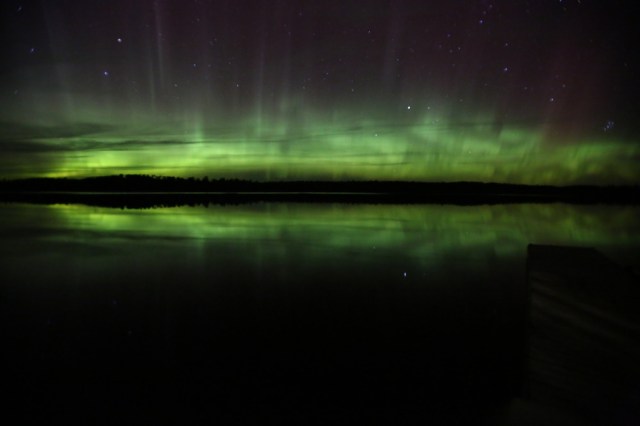
Located just a few miles from the Canadian border, this massive park is filled with rich forests bound by interconnected waterways. At night, millions of stars light up the sky, with the occasional glimmer of the Aurora Borealis blazing through the darkness.
By Day: Much of Voyageurs is only accessible by boat. From June through September, the park offers guided boat tours or ranger-led programs that will give you an inside look at the plants and animals that call this park home—including otters, bald eagles, moose, beavers, and wolves.
By Night: With its lack of light pollution and remote location, this park is as dark as it gets, with mesmerizing views of the Milky Way, the planets, and millions of stars—as well as the occasional dance of the Aurora Borealis. Basically, anywhere you go within the park on a cloudless night will offer spectacular views, though the NPS recommends the Voyageurs Forest Overlook, Beaver Pond Overlook, and the Kettle Falls Dam as the most popular stargazing locations.
In August, the park hosts its annual Star Party, with special ranger programs, Perseid meteor shower viewing, constellation tours, and more.
Best Time to Go: Summer and early fall (when the leaves change!)
More information: Nps.gov
Need some fresh ideas?
Subscribe to our weekly newsletter for expert parenting tips and simple solutions that make life instantly better.
By subscribing you agree to Tinybeans Terms and Privacy Policy










